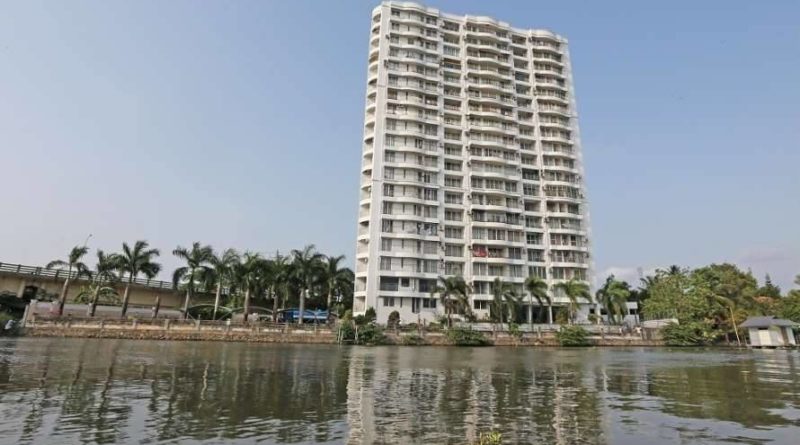Vembanad: A lake in the cross-hairs of development
Following a Supreme Court ultimatum in early September, life has taken an unexpected turn for I. Balachandran, 63, and Parvathy, 55, a sprightly couple who were leading a sedate life at a premium luxury river-view apartment in Maradu, Ernakulam. The duo turned protesters probably for the first time in their lives on September 6, the day the order came, to protect their dwelling at Alfa Serene, an apartment complex on the banks of the Vembanad lake, a wetland designated under the Ramsar Convention.
The apex court’s directive called for the demolition of the complex, and of three other high-rise residential structures, by September 20, for violating Coastal Regulation Zone (CRZ) guidelines. Following the ruling, the couple, along with 350 other families, have been plunged into deep gloom.
The order came as a rude shock not just to residents living in the four complexes — Alfa Serene, Holy Faith H2O, Jain Coral Cove and Golden Kayaloram — all built along the lake in the Maradu municipality, but also to the State government. The Supreme Court judges, annoyed with the non-implementation of earlier court orders, asked the Kerala government to complete the task by September 20 and file a report on September 23, when the court is to consider the case again.
Protests and rallies
Following the directive, Balachandran and Parvathy, along with the other affected residents, have begun organising themselves to impress upon the State government that they have done no wrong. Every day at 8.30 a.m., they join other protesters at H2O Holy Faith. From shouting slogans to meeting political leaders paying a visit in solidarity and giving sound bytes to TV cameras and interacting with journalists, they spend their day at the apartment’s portico, which has come to resemble the venue of a public agitation. It is at around 8.30 p.m. that they retire to their home, at the close of a tiring day of shouting slogans. Flags of all political parties are seen stuck on the imposing 10-feet tall gates of the flat complex. Those conducting political rallies in solidarity with the residents converge here, with fiery speeches electrifying the environment.
“Hands off my home,” cries the badge that Parvathy has pinned to her cream-coloured dupatta. “The rhythm of our life has changed dramatically over the last few days and I am unable to focus on my business. Most part of the day is spent here, participating in the agitation, garnering support from the general public and political parties and discussing the strategies with others who too are facing the same threat,” says Balachandran.
“There has not been any outing, entertainment, or even laughter in our lives since the court verdict,” laments Parvathy, sitting on the steps of the apartment on a windy afternoon. “We fully respect the Supreme Court verdict but believe that the judgment is the outcome of an erroneous report. We are innocent buyers who are frightened about losing our homes for no fault of ours,” says Balachandran.
Riding on the demand for waterfront apartments in the early years of the millennium, many builders constructed complexes on the banks of rivers and lakes in Kerala, often in blatant violation of environmental guidelines and laws that govern development activities in the ecologically sensitive coastal belt. The Supreme Court’s order suggests that it cannot be business as usual anymore for the developers. If the floods of last year dented the quest for such structures, the apex court order this year has caused thousands of families that have set up their homes in high-rises close to water bodies across the State to press the panic button.
Following the ultimatum, the Maradu high-rises seem to have become a talking point and the State government has been left with the constitutional obligation to execute the order. This unprecedented development has also brought together almost all political parties in Kerala who feel that a humane approach is needed when dealing with the demolition order.
From the State secretary of the ruling CPI(M) to MPs and MLAs of various political shades, all have thrown their weight behind the apartment owners. However, former Chief Minister and veteran CPI(M) leader V.S. Achuthanandan, former State Congress president V.M. Sudheeran and CPI State secretary Kanam Rajendran have struck a different note, demanding the strict implementation of the order and action against the erring builders.
As discussions on the issue dominate the State’s social and political spaces, the residents of the apartments have defied the eviction notice served by the Maradu municipality and resolved not to move out. Some have even threatened to end their lives if their homes are demolished, making it a volatile issue for the authorities.
Noted filmmaker Blessy, a resident of Holy Faith H2O, who is originally from Thiruvalla, bought his apartment here as “most of the work related to the film industry was taking place in the city [Kochi].” However, unlike most apartment owners, who bought directly from the builders, Blessy bought his flat from a long-time acquaintance.
“Before buying it, I got all the documents vetted by a lawyer. Some of the banks had also issued loans for other apartments in the building. I checked the legal status of the buildings with Major Ravi, another filmmaker who was the president of the association of the residents. He too gave the green signal and I purchased it,” says Blessy. “The Maradu municipality had issued all the relevant certificates. I had also been paying the property tax. One tends to count on these certificates as proof of the genuineness and the legal validity of the structures,” explains the filmmaker.
“We had no inkling of the legal tangles until news about the court cases began trickling in,” says Shamsudheen Karunagapally, a lawyer coordinating the protests. “Would anyone knowingly pay for a building that is likely to invite invite legal trouble for its residents?” he asks. Interestingly, the list of owners of these structures includes some lawyers, who are also now actively involved in defending their homes from being destroyed. The residents are knocking all doors in their desperate efforts to save their homes and have appealed to the President, the Prime Minister, the Kerala Governor, and MPs and MLAs from the State, seeking their intervention.
Legal battle on since 2007
It all began in 2007 when the Maradu panchayat, which was later elevated to a municipality, issued a show-cause notice to five builders, citing violations of CRZ norms, Floor Area Ratio and other rules. The vigilance wing of the Local Self Government Department of the State government had detected anomalies in the issue of building permits and directed the local body to revoke the permits. When the case reached the Kerala High Court the same year, a Single Judge allowed a writ petition filed by the builders. Later, a Division Bench ruled that the builders could not be taken to task for not referring the building applications to Kerala Coastal Zone Management Authority (KCZMA) for a ‘No-Objection Certificate’ — a mandatory clearance. Though the Authority sought to review the decision, the High Court didn’t entertain it.
It was a Special Leave Petition filed by the KCZMA in the Supreme Court against the Kerala High Court’s order that turned out to be the game-changer in Kerala, whose 580-km long coastline is dotted with thousands of constructions including homes, hotels, commercial buildings and resorts.
Incidentally, the Supreme Court had, in 2013, highlighted the ecological importance of the Vembanad lake system in a verdict in which it upheld a decision of the Kerala High Court to demolish some illegal constructions made along the lake. Following the decision, a resort on the Vettila Thuruthu — an island in the lake — demolished parts of its structure identified as illegal. The case of Kapico resorts, another massive structure erected on the Nediyathuruthu island in the lake, is still pending.
The court had then observed that the lake was “undergoing severe environmental degradation due to increased human intervention.”
Suo motu action
Initiating suo motu action, the court remarked that “there has been large-scale encroachment and illegal constructions are going on in violation of the CRZ notifications.” It also issued a notice to various agencies, including the State Pollution Control Board, seeking explanation on the steps taken to “implement CRZ [regulations], in the lake and [on] the islands as a whole”. The notice also asked the agencies to spell out what has been done to avert pollution and restore the illegally reclaimed banks of the lake.
“The collusion of some local body officials with the violators and encroachers has resulted in the Maradu situation where a large number of purchasers are now being pushed out of their homes,” feels B. Madhusoodana Kurup, former Vice-Chancellor of the Kerala University for Fisheries and Ocean Sciences, Kochi. The civic authorities of Maradu turned a blind eye to the letters and reminders from the KCZMA asking them to abide by the CRZ rules and send the building applications for clearance. If the directions had been implemented, the unprecedented crisis in Maradu could have been averted, says Kurup, who has served as a member of the Authority. The builders cannot claim immunity and feign ignorance about the regulations, he adds.
According to K.V. Thomas, former head of the Coastal Process Group of the National Centre for Earth Science Studies, Thiruvananthapuram, the Maradu municipality and the Kochi Corporation both ignored directions by KCZMA to identify the CRZ violations in their respective areas.
“In January 2014, nearly 5,000 suspected cases of CRZ violations were identified in the (structures) bordering the Vembanad lake using satellite images. The identification was carried out after a Supreme Court direction to identify the violations. Though the officials of the local bodies concerned were asked to physically verify the violations, they didn’t take up the task,” says Thomas, who had served as an expert member on several committees formed by the Authority. He also points out that an earlier direction from the Union Ministry for Environment, Forest and Climate Change to identify and report the CRZ violations was also ignored by the local bodies.
Defending the cause of the four builders, Mathew Kurian, the lawyer who represented them in the Kerala High Court, holds the Authority solely responsible for the current fiasco. If at all there were violations or irregularities as alleged, the Authority, which has been in the courts since 2007, should have pointed it out. All the developments were taking place in front of its eyes and it didn’t respond to it, he alleges. Regarding the ‘No Objection Certificate’ that the builders were expected to obtain from the KCZMA before proceeding with construction, Kurian says it was the responsibility of Maradu municipality and not the project proponents to send the files for clearance.
The Maradu developments have also triggered a sudden interest in another case in which the apex court let off the builder, DLF Universal Limited, which had constructed an apartment structure along the eastern banks of the Chilavannoor lake — an extension of Vembanad lake — with a fine of ₹1 crore.
While the Kerala High Court had initially ordered the demolition of parts of the building for violating the CRZ norms, the court’s Division Bench later limited the punishment to a fine. The Supreme Court, which upheld the Division Bench’s decision, slammed the KCZMA for its inaction in the case. The Authority “cannot wash its hands off by giving an explanation for inaction as the alleged absence of an enforcement force.” Had it played its role, the violations would not have happened, the court noted.
However, an official of the Authority feels that the two cases aren’t comparable as DLF had applied for CRZ and environmental clearances from the State government. But, in the Maradu case, no one had ever applied for a clearance, he says.
He also dismisses the argument made by some builders that once the more accommodative provisions of the CRZ 2019 notification become applicable, new buildings could be constructed at the same site after demolishing the existing buildings. Such construction can only be along the building line of a structure which was authorised and constructed before February 19, 1991, the cut-off date specified in the 2011 notification, he points out.
While earlier, Maradu was a ‘panchayat’ and hence fell under CRZ-III, at present, it is a ‘municipality’ (developed area) and comes under CRZ-II, applicable for urban areas. As per the 2011 norms, construction is allowed under CRZ-II areas towards the landward side of the authorised buildings or roads approved and completed before February 19, 1991.
A fast-shrinking lake
Man-made interventions have taken a toll on the fast-shrinking Vembanad lake, which supports an ecosystem that has sustained life in the three districts of Ernakulam, Alappuzha, and Kottayam. The lake is receding at an estimated rate of 0.288 sq. km each year, says P.K. Dinesh Kumar, scientist-in-charge of the National Institute of Oceanography, Kochi. The spread of the lake, around 130.68 sq. km, in 1967, reduced to 9.382 sq. km in 2004 and 3.292 sq. km in 2011, he points out.
There have been encroachments for agricultural expansion, aquaculture, large engineering structures, harbour development and tourism.
The Kerala government, after being pulled up by the apex court, has obtained a demolition impact assessment report from the Indian Institute of Technology-Madras, which has cautioned it about the possible environmental impact of bringing the buildings down, including contamination of the lake due to the debris.
The local body, says T.H. Nadeera, the chairperson of Maradu municipality, will wait for instructions from the State government in the case. “We are waiting for the directions,” she says.
It would be a crisis of an unprecedented nature, with constitutional, ecological and humanitarian implications, that the State government may have to tackle if it fails to satisfy the Supreme Court’s instructions as the latter takes up the case on Monday. For now, the critically vulnerable coastal area of Vembanad lake is in the cross-hairs of development and politics.
This was originally published by The Hindu




